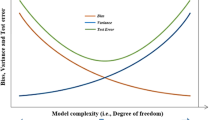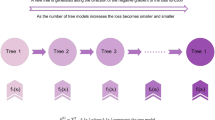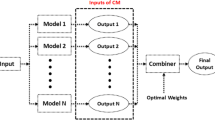Abstract
Several thermodynamic models have been proposed in literature to estimate the amount of asphaltene precipitation (AAP); however, they usually need several many inputs, and the characterization of the samples is often not accurate enough. This paper compares the performance of four data-driven methods, including Extreme Gradient Boosting (XGBoost), Multi-Layer Perceptron (MLP), Least Squares – Support Vector Machine coupled with a Particle Swarm Optimization (LSSVM-PSO), and Multilinear Regression (MLR), to predict the AAP as a function of oil composition, API, SARA fractions, solvent molar mass, dilution ratio, pressure, and temperature. The dataset includes 1703 samples, 20% of which is used for testing. An innovative nested K-fold cross-validation is also proposed to tune the hyperparameters of the data-driven methods. The contributions of this work include a comparison of the performance of different data-driven methods to estimate the AAP and introducing a novel cross-validation technique. Data-driven results are compared with those of the Perturbed Chain – Statistical Associating Fluid Theory Equation of State. The results reveal the superiority of the data-driven methods over the thermodynamic model, except for the MLR. Meanwhile, XGBoost showed the best performance among other data-driven methods. Coefficients of determination of 99.57%, 98.96%, 98.17%, 85.23%, and 90.40% were achieved by the XGBoost, LSSVM-PSO, MLP, MLR, and the thermodynamic model, respectively. Finally, it is shown that the proposed nested K-fold cross-validation positively affected the generalization of the data-driven methods. The findings of this study can help engineers select reliable methods to estimate the AAP and improve their generalization using the nested K-fold cross-validation.





Similar content being viewed by others
Data availability
Data is confidential and cannot be shared.
References
Ahmadi MA (2011) Prediction of asphaltene precipitation using artificial neural network optimized by imperialist competitive algorithm. J Pet Explor Prod Technol 1:99–106. https://doi.org/10.1007/s13202-011-0013-7
Ahmadi MA (2012) Neural network based unified particle swarm optimization for prediction of asphaltene precipitation. Fluid Phase Equilib 314:46–51. https://doi.org/10.1016/j.fluid.2011.10.016
Ahmadi MA, Ebadi M (2014) Evolving smart approach for determination dew point pressure through condensate gas reservoirs. Fuel 117:1074–1084. https://doi.org/10.1016/j.fuel.2013.10.010
Ahmadi P, Aghajanzadeh M, Asaadian H et al (2022) Ion-mediated desorption of asphaltene molecules from carbonate and sandstone structures. Mater Res Express 9:65101. https://doi.org/10.1088/2053-1591/ac784f
Ashoori S, Abedini A, Abedini R, Nasheghi KQ (2010) Comparison of scaling equation with neural network model for prediction of asphaltene precipitation. J Pet Sci Eng 72:186–194. https://doi.org/10.1016/j.petrol.2010.03.016
Asoodeh M, Bagheripour P (2012) Prediction of compressional, shear, and Stoneley wave velocities from conventional well log data using a committee machine with intelligent systems. Rock Mech Rock Eng 45:45–63. https://doi.org/10.1007/s00603-011-0181-2
Asoodeh M, Bagheripour P (2013) Core porosity estimation through different training approaches for neural network: Back-propagation learning vs. genetic algorithm. Int J Comput Appl 63:11–15. https://doi.org/10.5120/10461-5172
Asoodeh M, Kazemi K (2013) Estimation of bubble point pressure: using a genetic integration of empirical formulas. Energy Sources, Part A Recover Util Environ Eff 35:1102–1109. https://doi.org/10.1080/15567036.2011.574195
Baghban A, Ahmadi MA, Pouladi B, Amanna B (2015a) Phase equilibrium modeling of semi-clathrate hydrates of seven commonly gases in the presence of TBAB ionic liquid promoter based on a low parameter connectionist technique. J Supercrit Fluids https://doi.org/10.1016/j.supflu.2015.03.004
Baghban A, Ali M, Hashemi B (2015b) Prediction carbon dioxide solubility in presence of various ionic liquids using computational intelligence approaches. J Supercrit Fluids 98:50–64. https://doi.org/10.1016/j.supflu.2015.01.002
Bemani A, Kazemi A, Ahmadi M et al (2022) Rigorous modeling of frictional pressure loss in inclined annuli using artificial intelligence methods. J Pet Sci Eng 211:110203. https://doi.org/10.1016/j.petrol.2022.110203
Buenrostro-Gonzalez E, Espinosa-Peña M, Andersen SI, Lira-Galeana C (2001) Characterization of asphaltenes and resins from problematic Mexican crude oils. Pet Sci Technol 19:299–316. https://doi.org/10.1081/LFT-100000764
Chamkalani A, Zendhboudi S, Bahadori A et al (2014) Integration of LSSVM technique with PSO to determine Asphaltene deposition. J Pet Sci Eng. https://doi.org/10.1016/j.petrol.2014.10.001
Cheraghi Y, Kord S, Mashayekhizadeh V (2021) Application of machine learning techniques for selecting the most suitable enhanced oil recovery method; challenges and opportunities. J Pet Sci Eng 205:108761. https://doi.org/10.1016/j.petrol.2021.108761
Daryasafar A, Masoudi M, Kord S, Madani M (2020) Evaluation of different thermodynamic models in predicting asphaltene precipitation: a comparative study. Fluid Phase Equilib 514:112557. https://doi.org/10.1016/J.FLUID.2020.112557
Dehaghani AHS, Taleghani MS, Badizad MH, Daneshfar R (2019) Simulation study of the Gachsaran asphaltene behavior within the interface of oil/water emulsion: a case study. Colloid Interface Sci Commun 33:100202. https://doi.org/10.1016/j.colcom.2019.100202
Dehaghani YH, Assareh M, Feyzi F (2018) Asphaltene precipitation modeling with PR and PC-SAFT equations of state based on normal alkanes titration data in a multisolid approach. Fluid Phase Equilib 470:212–220. https://doi.org/10.1016/J.FLUID.2017.11.012
Duda Y, Lira-Galeana C (2006) Thermodynamics and Structure of Asphaltene Aggregation,” Special Issue of Fluid Phase Equilibria. Fluid Phase Equilib 214:257–267
Eslamimanesh A, Gharagheizi F, Mohammadi AH, Richon D (2013) Assessment test of sulfur content of gases. Fuel Process Technol 110:133–140. https://doi.org/10.1016/j.fuproc.2012.12.005
Fazeli M, Escrochi M, Hosseini ZS, Vaferi B (2022) Experimental analyzing the effect of n-heptane concentration and angular frequency on the viscoelastic behavior of crude oil containing asphaltene. Sci Rep 12:3965. https://doi.org/10.1038/s41598-022-07912-y
Ghasemi S, Jafari Behbahani T, Mohammadi M et al (2022) Experimental investigation and thermodynamic modeling of asphaltene precipitation during pressure depletion and gas injection at HPHT conditions in live oil using PC-SAFT EoS. Fluid Phase Equilib 562:113549. https://doi.org/10.1016/J.FLUID.2022.113549
Gholami M, Ranjbargol M, Yousefzadeh R, Ghorbani Z (2023) Integrating three smart predictive models using a power-law committee machine for the prediction of compressive strength in masonry made of clay bricks and cement mortar. Structures 55:951–964. https://doi.org/10.1016/j.istruc.2023.06.058
Ghorbani M, Zargar G, Jazayeri-Rad H (2016) Prediction of asphaltene precipitation using support vector regression tuned with genetic algorithms. Petroleum 2:301–306. https://doi.org/10.1016/J.PETLM.2016.05.006
Golden RM (1996) Mathematical methods for neural network analysis and design, 1st edn. MIT Press. https://doi.org/10.5555/548086
Gonzalez DL, Vargas FM, Hirasaki GJ, Chapman WG (2008) Modeling study of CO2-induced asphaltene precipitation. Energy Fuel 22:757–762. https://doi.org/10.1021/ef700369u
Goodall, CR (1993) 13 Computation using the QR decomposition. In: Computational statistics, vol 9. Elsevier, pp 467–508. https://doi.org/10.1016/S0169-7161(05)80137-3
Hadavimoghaddam F, Ostadhassan M, Heidaryan E et al (2021) Prediction of dead oil viscosity: machine learning vs. Class Correlations Energi 14:930. https://doi.org/10.3390/en14040930
Hu YF, Chen GJ, Yang JT, Guo TM (2000) A study on the application of scaling equation for asphaltene precipitation. Fluid Phase Equilib 171:181–195. https://doi.org/10.1016/S0378-3812(00)00348-4
Hu YF, Li S, Liu N et al (2004) Measurement and corresponding states modeling of asphaltene precipitation in Jilin reservoir oils. J Pet Sci Eng 41:169–182. https://doi.org/10.1016/S0920-4105(03)00151-7
Hubert M (2009) Comprehensive chemometrics: chemical and biochemical data analysis. In: Steven Brown, Roma Tauler, Beata Walczak 4:315–343
Ilkhchi AK, Rezaee M, Moallemi SA (2006) A fuzzy logic approach for estimation of permeability and rock type from conventional well log data: an example from the Kangan reservoir in the Iran offshore gas field. J Geophys Eng 3:356–369. https://doi.org/10.1088/1742-2132/3/4/007
Jang I, Oh S, Kim Y et al (2018) Well-placement optimisation using sequential artificial neural networks. Energy Explor Exploit 36:433–449. https://doi.org/10.1177/0144598717729490
Ke J, Zheng H, Yang H, Michael X (2017) Short-term forecasting of passenger demand under on-demand ride services : a spatio-temporal deep learning approach. Transp Res Part C 85:591–608. https://doi.org/10.1016/j.trc.2017.10.016
Khanifar A, Demiral B, Darman N (2012) Modelling of asphaltene precipitation and deposition during WAG application. In: Society of Petroleum Engineers - international petroleum technology conference 2012. IPTC 2012, pp 57–67. https://doi.org/10.2523/IPTC-14147-MS
Kokal SL, Najman J, Sayegh SG, George AE (1992) Measurement and correlation of Asphaltene precipitation from heavy oils by gas injection. J Can Pet Technol 31:. https://doi.org/10.2118/92-04-01
Kord S, Ayatollahi S (2012) Asphaltene precipitation in live crude oil during natural depletion: Experimental investigation and modeling. Fluid Phase Equilib 336:63–70. https://doi.org/10.1016/J.FLUID.2012.05.028
Kurup AS, Wang J, Subramani HJ et al (2012) Revisiting asphaltene deposition tool (ADEPT): field application. Energy Fuel 26:5702–5710. https://doi.org/10.1021/ef300714p
Lashkenari MS, Taghinezhad M, Mehdizadeh B (2013) Viscosity prediction in selected Iranian light oil reservroirs: artificial neural networks versus empirical correlations. Pet Sci 10:126–133
Lawal KA, Crawshaw JP, Boek ES, Vesovic V (2012) Experimental investigation of asphaltene deposition in capillary flow. Energy Fuel 26:2145–2153. https://doi.org/10.1021/ef201874m
Leontaritis KJ, Mansoori GA (1987) Asphaltene flocculation during oil production and processing: a thermodynamic Collodial model. In: Paper presented at the SPE international symposium on oilfield chemistry. OnePetro, San Antonio, Texas
Li J, Zhang L, Wu Z et al (2020) Autonomous Martian rock image classification based on transfer deep learning methods. Earth Sci Inf 13:951–963. https://doi.org/10.1007/s12145-019-00433-9
Mansoori GA (1997) Modeling of asphaltene and other heavy organic depositions. J Pet Sci Eng 17:101–111. https://doi.org/10.1016/s0920-4105(96)00059-9
Mashhadi Meighani H, Ghotbi C, Jafari Behbahani T, Sharifi K (2018) Evaluation of PC-SAFT model and support vector regression (SVR) approach in prediction of asphaltene precipitation using the titration data. Fluid Phase Equilib 456:171–183. https://doi.org/10.1016/J.FLUID.2017.10.022
Masoudi M, Parvin S, Miri R, Kord S, Hellevang H (2021) Implementation of PC-SAFT equation of state into MRST compositional for modelling of Asphaltene precipitation. In: 82nd EAGE Annual Conference & Exhibition. European Association of Geoscientists & Engineers, pp 1–5. https://doi.org/10.3997/2214-4609.202011432
Min BH, Park C, Kang JM et al (2011) Optimal well placement based on artificial neural network incorporating the productivity potential. Energy Sources, Part A Recover Util Environ Eff 33:1726–1738. https://doi.org/10.1080/15567030903468569
Mohammadi AH, Gharagheizi F, Eslamimanesh A, Richon D (2012) Evaluation of experimental data for wax and diamondoids solubility in gaseous systems. Chem Eng Sci 81:1–7. https://doi.org/10.1016/j.ces.2012.06.051
Moncayo-Riascos I, Guerrero-Benavides C, Giraldo J et al (2022) Integrated machine learning model for predicting Asphaltene damage risk and the Asphaltene onset pressure. Energy Fuel 36:14243–14252. https://doi.org/10.1021/acs.energyfuels.2c03319
Moosavi SR, Vaferi B, Wood DA (2020) Auto-detection interpretation model for horizontal oil wells using pressure transient responses. Adv geo-energy Res 4:305–316. https://doi.org/10.46690/ager.2020.03.08
Na’imi SR, Gholami A, Asoodeh M (2014) Prediction of crude oil Asphaltene precipitation using support vector regression. J Dispers Sci Technol 35:518–523. https://doi.org/10.1080/01932691.2013.798585
Nazari F, Assareh M, Vahabzadeh Asbaghi E (2021) Asphaltene formation modeling using vapor-liquid-liquid equilibrium calculations by PC-SAFT for reservoir and surface conditions. J Pet Sci Eng 198:108209. https://doi.org/10.1016/j.petrol.2020.108209
Nguyen DD, Daneshfar R, Dehaghani AHS, Su C-H (2021) The effect of shear rate on aggregation and breakage of asphaltenes flocs: experimental study and model-based analysis. J Mol Liq 325:114861. https://doi.org/10.1016/j.molliq.2020.114861
Nwachukwu A, Jeong H, Sun A, Pyrcz M, Lake LW (2018) Machine learning-based optimization of well locations and WAG parameters under geologic uncertainty. In: SPE Improved Oil Recovery Conference, Tulsa, Oklahoma, USA, Conference, April 2018. https://doi.org/10.2118/190239-MS
Onwunalu JE, Durlofsky LJ (2009) Development and application of a new well pattern optimization algorithm for optimizing large scale field development. In: SPE annual technical conference and exhibition. New Orleans, Louisiana, October 2009. https://doi.org/10.2118/124364-MS
Qin X, Wang P, Sepehrnoori K, Pope GA (2000) Modeling asphaltene precipitation in reservoir simulation. Ind Eng Chem Res 39:2644–2654. https://doi.org/10.1021/ie990781g
Rassamdana H, Dabir B, Nematy M et al (1996) Asphalt flocculation and deposition: I. The Onset of Precipitation AIChE J 42:10–22. https://doi.org/10.1002/aic.690420104
Rasuli Nokandeh N, Khishvand M, Naseri A (2012) An artificial neural network approach to predict asphaltene deposition test result. Fluid Phase Equilib 329:32–41. https://doi.org/10.1016/j.fluid.2012.06.001
Razghandi M, Dehghan A, Yousefzadeh R (2021) Application of particle swarm optimization and genetic algorithm for optimization of a southern Iranian oilfield. J Pet Explor Prod 11:1781–1796. https://doi.org/10.1007/s13202-021-01120-6
Rostami A, Arabloo M, Lee M, Bahadori A (2018) Applying SVM framework for modeling of CO 2 solubility in oil during CO 2 fl ooding. Fuel 214:73–87. https://doi.org/10.1016/j.fuel.2017.10.121
Rousseeuw PJ, Leroy AM (2005) Robust regression and outlier detection. In: Wiley series in probability and statistics. https://doi.org/10.1002/0471725382
Sagheer A, Kotb M (2019) Time series forecasting of petroleum production using deep LSTM recurrent networks. Neurocomputing 323:203–213. https://doi.org/10.1016/j.neucom.2018.09.082
Suykens JA, Vandewalle J (1999) Least squares support vector machine classifiers. Neural Process Lett 9:293–300. https://doi.org/10.1023/A:1018628609742
Tazikeh S, Davoudi A, Shafiei A et al (2022) A comparison between the perturbed-chain statistical associating fluid theory equation of state and machine learning modeling approaches in Asphaltene onset pressure and bubble point pressure prediction during gas injection. ACS Omega 7:30113–30124. https://doi.org/10.1021/acsomega.2c03192
Vanani MB, Daneshfar R, Khodapanah E (2019) A novel MLP approach for estimating asphaltene content of crude oil. Pet Sci Technol 37:2238–2245. https://doi.org/10.1080/10916466.2018.1474223
Wu J, Prausnitz JM, Prausnitz JM (1998) Molecular-thermodynamic framework for asphaltene-oil equilibria. AICHE J 44:1188–1199. https://doi.org/10.1002/aic.690440516
Xue J, Li C, He Q (2019) Modeling of wax and asphaltene precipitation in crude oils using four-phase equilibrium. Fluid Phase Equilib 497:122–132. https://doi.org/10.1016/J.FLUID.2019.06.011
Yang X, Dindoruk B, Lu L (2019) A comparative analysis of bubble point pressure prediction using advanced machine learning algorithms and classical correlations. J Pet Sci Eng https://doi.org/10.1016/j.petrol.2019.106598
Yousefzadeh R, Ahmadi M (2023a) Improved history matching of channelized reservoirs using a novel deep learning-based parametrization method. Geoenergy Sci Eng 229:212113. https://doi.org/10.1016/j.geoen.2023.212113
Yousefzadeh R, Ahmadi M (2023b) Fast marching method assisted permeability upscaling using a hybrid deep learning method coupled with particle swarm optimization. Geoenergy Sci Eng 212211. https://doi.org/10.1016/j.geoen.2023.212211
Yousefzadeh R, Ahmadi M, Kazemi A (2022a) Toward investigating the application of reservoir opportunity index in facilitating well placement optimization under geological uncertainty. J Pet Sci Eng 215:110709. https://doi.org/10.1016/J.PETROL.2022.110709
Yousefzadeh R, Bemani A, Kazemi A, Ahmadi M (2022b) An insight into the prediction of scale precipitation in harsh conditions using different machine learning algorithms. SPE Prod Oper 1–19. https://doi.org/10.2118/212846-PA
Yousefzadeh R, Kazemi A, Ahmadi M, Gholinezhad J (2023) History matching and robust optimization using proxies. 115–132. https://doi.org/10.1007/978-3-031-28079-5_6
Yousefzadeh R, Sharifi M, Rafiei Y (2021) An efficient method for injection well location optimization using fast marching method. J Pet Sci Eng 204:. https://doi.org/10.1016/j.petrol.2021.108620
Yousefzadeh R, Sharifi M, Rafiei Y, Ahmadi M (2020) Dynamic selection of realizations for injection well location optimization. In: 82nd EAGE Annual Conference & Exhibition. European Association of Geoscientists & Engineers, Amsterdam, pp 1–5
Zheng J, Lu C, Gao L (2019) Multi-objective cellular particle swarm optimization for wellbore trajectory design. Appl Soft Comput 77:106–117. https://doi.org/10.1016/J.ASOC.2019.01.010
Funding
No funding was received to assist with the preparation of this manuscript.
Author information
Authors and Affiliations
Contributions
Conceptualization: Jafar Khalighi, Alexey Cheremisin; Methodology: Jafar Khalighi; Formal analysis and investigation: Jafar Khalighi; Writing - original draft preparation: Jafar Khalighi; Writing - review and editing: Alexey Cheremisin; Resources: Jafar Khalighi, Alexey Cheremisin; Supervision: Alexey Cheremisin.
Corresponding author
Ethics declarations
Conflicts of interest/competing interests
The authors declare no conflict/competing interest.
Additional information
Communicated by: H. Babaie
Publisher’s note
Springer Nature remains neutral with regard to jurisdictional claims in published maps and institutional affiliations.
Rights and permissions
Springer Nature or its licensor (e.g. a society or other partner) holds exclusive rights to this article under a publishing agreement with the author(s) or other rightsholder(s); author self-archiving of the accepted manuscript version of this article is solely governed by the terms of such publishing agreement and applicable law.
About this article
Cite this article
Khalighi, J., Cheremisin, A. Comparative study of machine learning algorithms in predicting asphaltene precipitation with a novel validation technique. Earth Sci Inform 16, 3097–3111 (2023). https://doi.org/10.1007/s12145-023-01075-8
Received:
Accepted:
Published:
Issue Date:
DOI: https://doi.org/10.1007/s12145-023-01075-8




